Whirlpool WRF560SMHM00, WRF560SMHW00, WRF560SMHV00, WRF560SMHB00 Owner’s Manual

REFRIGERATOR
USER INSTRUCTIONS
THANK YOU for purchasing this high-quality product. Register your new refrigerator at www.whirlpool.com. In Canada, register your refrigerator at www.whirlpool.ca.
For future reference, please make a note of your product model and serial numbers. These can be located on the inside wall of the refrigerator compartment.
Model Number __________________________________________________ |
Serial Number __________________________________________________ |
Table of Contents / Índice / Table des matières
REFRIGERATOR SAFETY................................. |
2 |
INSTALLATION INSTRUCTIONS ..................... |
3 |
Unpack the Refrigerator ................................. |
3 |
Location Requirements................................... |
3 |
Remove and Replace Refrigerator |
|
Doors and Drawer Front ................................. |
4 |
Electrical Requirements .................................. |
8 |
Water Supply Requirements........................... |
8 |
Connect the Water Supply ............................. |
8 |
Handle Installation and Removal.................. |
10 |
Door Closing and Door Alignment................ |
11 |
FILTERS AND ACCESSORIES ....................... |
11 |
Water Filtration System................................. |
11 |
Install Air Filter............................................... |
12 |
Install Produce Preserver.............................. |
12 |
Accessories................................................... |
13 |
REFRIGERATOR USE ..................................... |
13 |
Opening and Closing Doors ......................... |
13 |
Using the Controls ........................................ |
13 |
Water Dispenser ........................................... |
15 |
Ice Maker ...................................................... |
16 |
REFRIGERATOR FEATURES ......................... |
16 |
Refrigerator Shelves...................................... |
17 |
Pantry Drawer ............................................... |
17 |
Crisper........................................................... |
17 |
DOOR FEATURES ........................................... |
18 |
Condiment Bins ............................................ |
18 |
Fresh Bin ....................................................... |
18 |
Half-Height Bin.............................................. |
18 |
REFRIGERATOR CARE .................................. |
19 |
Cleaning ........................................................ |
19 |
Changing the Light Bulbs ............................. |
19 |
TROUBLESHOOTING ..................................... |
20 |
Operation ...................................................... |
20 |
Noise ............................................................. |
21 |
Temperature and Moisture ........................... |
22 |
Ice and Water................................................ |
23 |
Doors............................................................. |
25 |
PERFORMANCE DATA SHEET...................... |
26 |
WARRANTY...................................................... |
27 |
SEGURIDAD DEL REFRIGERADOR.............. |
28 |
INSTRUCCIONES DE INSTALACIÓN............ |
29 |
Desempaque el refrigerador......................... |
29 |
Requisitos de ubicación ............................... |
30 |
Cómo sacar y volver a colocar las puertas |
|
y el frente del cajón del refrigerador............. |
30 |
Requisitos eléctricos .................................... |
34 |
Requisitos del suministro de agua............... |
34 |
Conexión del suministro de agua................. |
34 |
Instalación y remoción de las manijas ......... |
36 |
Cierre y alineamiento de las puertas............ |
37 |
FILTROS Y ACCESORIOS.............................. |
38 |
Sistema de filtración de agua....................... |
38 |
Instalación del filtro de aire........................... |
38 |
Instalación del preservador |
|
de alimentos frescos .................................... |
39 |
Accesorios .................................................... |
40 |
USO DE SU REFRIGERADOR........................ |
40 |
Cómo abrir y cerrar las puertas.................... |
40 |
Uso de los controles..................................... |
40 |
Despachador de agua .................................. |
42 |
Fábrica de hielo ............................................ |
43 |
CARACTERÍSTICAS DEL |
|
REFRIGERADOR............................................. |
44 |
Estantes del refrigerador .............................. |
44 |
Cajón-despensa ........................................... |
44 |
Cajón para verduras ..................................... |
45 |
CARACTERÍSTICAS DE LA PUERTA............ |
45 |
Recipientes para condimento ...................... |
45 |
Recipiente para productos frescos.............. |
45 |
Recipiente de altura media........................... |
46 |
CUIDADO DE SU REFRIGERADOR .............. |
46 |
Limpieza........................................................ |
46 |
Cómo cambiar los focos .............................. |
46 |
SOLUCIÓN DE PROBLEMAS ........................ |
47 |
Funcionamiento............................................ |
47 |
Ruido............................................................. |
48 |
Temperatura y humedad.............................. |
49 |
Hielo y agua.................................................. |
50 |
Puertas.......................................................... |
52 |
HOJA DE DATOS DEL RENDIMIENTO......... |
53 |
GARANTÍA ....................................................... |
54 |
SÉCURITÉ DU RÉFRIGÉRATEUR.................. |
55 |
INSTRUCTIONS D’INSTALLATION................ |
56 |
Déballage du réfrigérateur ............................ |
56 |
Exigences d’emplacement............................ |
57 |
Retrait et réinstallation des portes |
|
du réfrigérateur et de l’avant du tiroir ........... |
57 |
Spécifications électriques ............................. |
61 |
Spécifications de l’alimentation en eau ........ |
61 |
Raccordement à l’alimentation en eau ......... |
61 |
Installation et démontage des poignées....... |
63 |
Fermeture et alignement de la porte............. |
64 |
FILTRES ET ACCESSOIRES........................... |
65 |
Système de filtration de l’eau ....................... |
65 |
Installation du filtre à air ................................ |
65 |
Installation du conservateur pour |
|
produits frais ................................................. |
66 |
Accessoires................................................... |
67 |
UTILISATION DU RÉFRIGÉRATEUR ............. |
67 |
Ouverture et fermeture des portes ............... |
67 |
Utilisation des commandes .......................... |
67 |
Distributeur d’eau.......................................... |
69 |
Machine à glaçons ........................................ |
70 |
CARACTÉRISTIQUES DU |
|
RÉFRIGÉRATEUR............................................ |
71 |
Tablettes du réfrigérateur.............................. |
71 |
Garde-manger............................................... |
71 |
Bac à légumes............................................... |
72 |
CARACTÉRISTIQUES DE LA PORTE ............ |
72 |
Balconnets à condiments ............................. |
72 |
Balconnet fraîcheur ....................................... |
72 |
Balconnet mi-hauteur.................................... |
73 |
ENTRETIEN DU RÉFRIGÉRATEUR ............... |
73 |
Nettoyage...................................................... |
73 |
Remplacement des ampoules d’éclairage ... |
74 |
DÉPANNAGE.................................................... |
75 |
Fonctionnement ............................................ |
75 |
Bruit ............................................................... |
76 |
Température et humidité............................... |
77 |
Glaçons et eau .............................................. |
78 |
Portes ............................................................ |
80 |
FEUILLE DE DONNÉES SUR LA |
|
PERFORMANCE .............................................. |
81 |
GARANTIE ........................................................ |
82 |
W10400960C
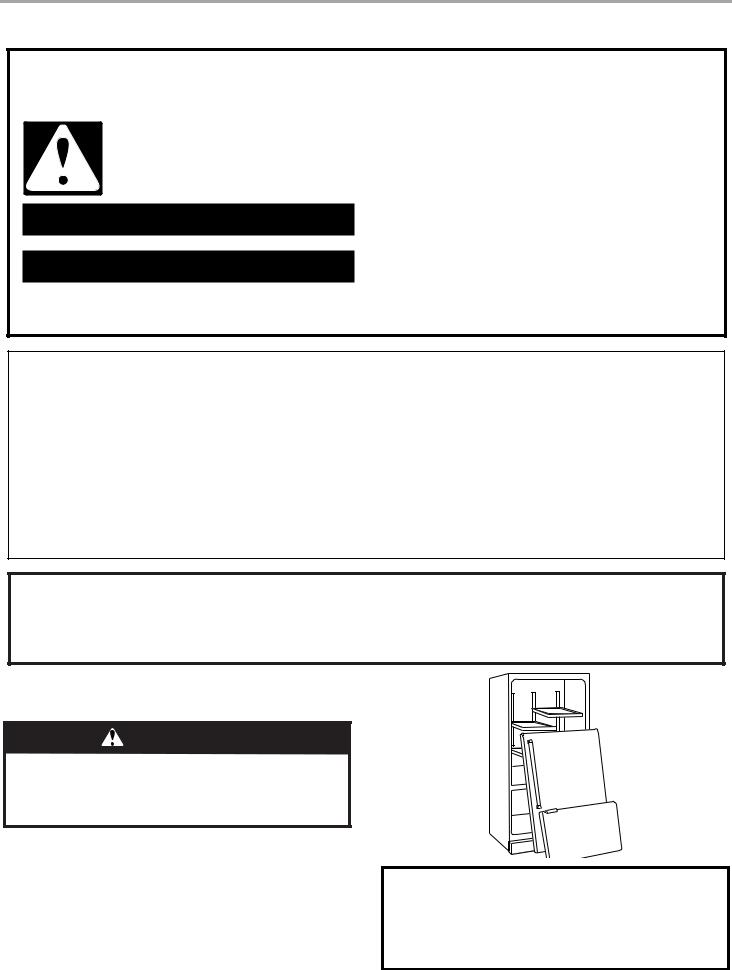
REFRIGERATOR SAFETY
Your safety and the safety of others are very important.
We have provided many important safety messages in this manual and on your appliance. Always read and obey all safety messages.
This is the safety alert symbol.
This symbol alerts you to potential hazards that can kill or hurt you and others.
All safety messages will follow the safety alert symbol and either the word “DANGER” or “WARNING.” These words mean:
 DANGER
DANGER
 WARNING
WARNING
You can be killed or seriously injured if you don't immediately follow instructions.
You can be killed or seriously injured if you don't follow instructions.
All safety messages will tell you what the potential hazard is, tell you how to reduce the chance of injury, and tell you what can happen if the instructions are not followed.
IMPORTANT SAFETY INSTRUCTIONS
WARNING: To reduce the risk of fire, electric shock, or injury when using your refrigerator, follow these basic precautions:
■ Plug into a grounded 3 prong outlet. |
■ Use nonflammable cleaner. |
|
■ Do not remove ground prong. |
■ Keep flammable materials and vapors, such as gasoline, |
|
■ Do not use an adapter. |
away from refrigerator. |
|
■ Use two or more people to move and install refrigerator. |
||
■ Do not use an extension cord. |
||
■ Disconnect power before installing ice maker (on ice maker |
||
■ Disconnect power before servicing. |
||
kit ready models only). |
||
■ Replace all parts and panels before operating. |
||
■ Use a sturdy glass when dispensing ice (on some models). |
||
■ Remove doors from your old refrigerator. |
||
■ Do not hit the refrigerator glass doors (on some models). |
||
|
SAVE THESE INSTRUCTIONS
State of California Proposition 65 Warnings:
WARNING: This product contains one or more chemicals known to the State of California to cause cancer.
WARNING: This product contains one or more chemicals known to the State of California to cause birth defects or other reproductive harm.
Proper Disposal of
Your Old Refrigerator
WARNING
Suffocation Hazard
Remove doors from your old refrigerator.
Failure to do so can result in death or brain damage.
IMPORTANT: Child entrapment and suffocation are not problems of the past. Junked or abandoned refrigerators are still dangerous – even if they will sit for “just a few days.” If you are getting rid
of your old refrigerator, please follow these instructions to help prevent accidents.
Before You Throw Away Your Old Refrigerator or Freezer:
■Take off the doors.
■Leave the shelves in place so that children may not easily climb inside.
Important information to know about disposal of refrigerants:
Dispose of refrigerator in accordance with Federal and Local regulations. Refrigerants must be evacuated by a licensed, EPA certified refrigerant technician in accordance with established procedures.
2

INSTALLATION INSTRUCTIONS
Unpack the Refrigerator
WARNING
Excessive Weight Hazard
Use two or more people to move and install refrigerator.
Failure to do so can result in back or other injury.
Remove the Packaging
■Remove tape and glue residue from surfaces before turning on the refrigerator. Rub a small amount of liquid dish soap over the adhesive with your fingers. Wipe with warm water and dry.
■Do not use sharp instruments, rubbing alcohol, flammable fluids, or abrasive cleaners to remove tape or glue. These products can damage the surface of your refrigerator. For more information, see “Refrigerator Safety.”
■Dispose of/recycle all packaging materials.
When Moving Your Refrigerator:
Your refrigerator is heavy. When moving the refrigerator for cleaning or service, be sure to cover the floor with cardboard or hardboard to avoid floor damage. Always pull the refrigerator straight out when moving it. Do not wiggle or “walk” the refrigerator when trying to move it, as floor damage could occur.
Clean Before Using
After you remove all of the packaging materials, clean the inside of your refrigerator before using it. See the cleaning instructions in “Refrigerator Care.”
Important information to know about glass shelves and covers:
Do not clean glass shelves or covers with warm water when they are cold. Shelves and covers may break if exposed to sudden temperature changes or impact, such as bumping. Tempered glass is designed to shatter into many small, pebble-size pieces. This is normal. Glass shelves and covers are heavy. Use both hands when removing them to avoid dropping.
Location Requirements
WARNING
Explosion Hazard
Keep flammable materials and vapors, such as gasoline, away from refrigerator.
Failure to do so can result in death, explosion, or fire.
To ensure proper ventilation for your refrigerator, allow for a ¹⁄" (1.25 cm) of space on each side and at the top. Allow for
a 1" (2.54 cm) space behind the refrigerator. If your refrigerator has an ice maker, allow extra space at the back for the water line connections. When installing your refrigerator next to a fixed wall, leave a 2" (5.08 cm) minimum space between the refrigerator and wall to allow the door to swing open.
NOTE: This refrigerator is intended for use in a location where the temperature ranges from a minimum of 55°F (13°C) to a maximum of 110°F (43°C). The preferred room temperature range for optimum performance, which reduces electricity usage and
provides superior cooling, is between 60°F (15°C) and 90°F (32°C). It is recommended that you do not install the refrigerator near
a heat source, such as an oven or radiator.
¹⁄" (1.25 cm)
2" (5.08 cm)
3
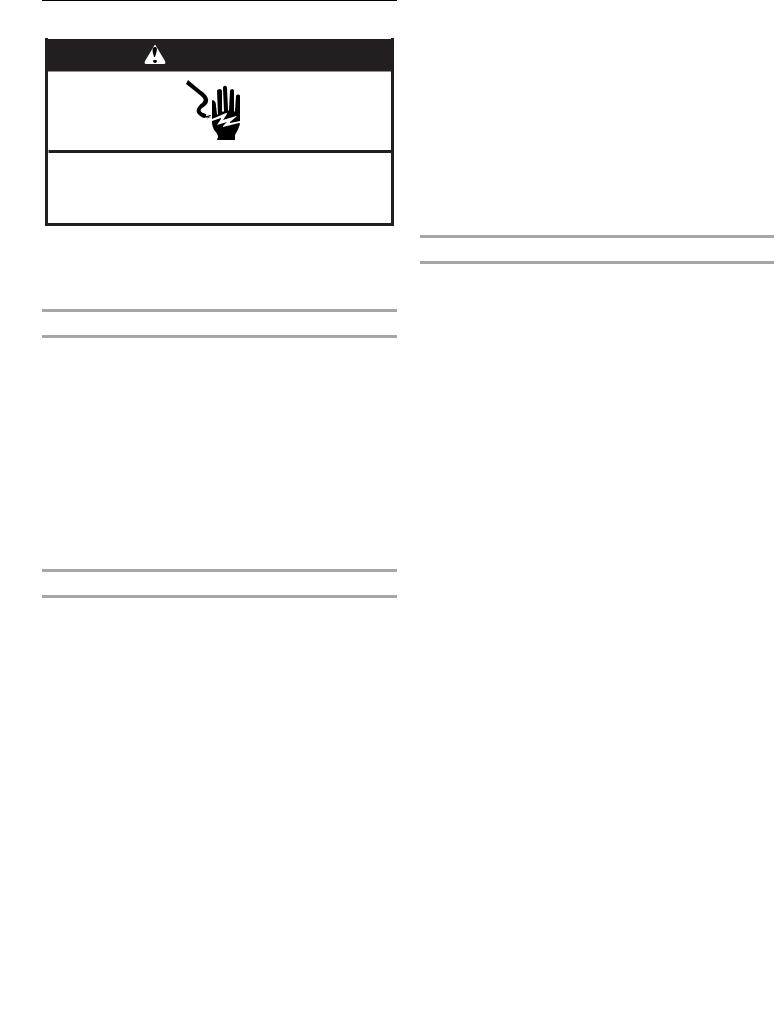
Remove and Replace Refrigerator
WARNING
Hazard
Disconnect power before removing doors.
Failure to do so can result in death or electrical shock.
Doors and Drawer Front
Depending on the width of your door opening, it may be necessary to remove the refrigerator doors to move the refrigerator into your home.
Remove Doors and Hinges
IMPORTANT:
■If the refrigerator was previously installed and you are moving it out of the home, before you begin, turn the refrigerator control OFF, and unplug the refrigerator or disconnect power. Remove food and any adjustable door or utility bins from doors.
■Keep the refrigerator doors closed until you are ready to lift them free from the cabinet. Provide additional support for the refrigerator door while the hinges are being removed. Do not depend on the door gasket magnets to hold the door in place while you are working.
■All graphics referenced in the following instructions are included later in this section after “Final Steps.”
TOOLS NEEDED: ⁄", ³⁄", and ¹⁄" hex head socket wrenches, Torx®† T25 screwdriver, #2 Phillips screwdriver, and a flat-blade screwdriver.
Remove Doors and Hinges
1.Unplug refrigerator or disconnect power.
2.Remove the base grille. Grasp the grille firmly and pull it toward you.
3.Starting with the right-hand side door, remove the parts for the top hinge as shown in Top Hinge graphic. Lift the refrigerator door from the bottom hinge pin.
4.Remove the hinge pin cover from the bottom hinge pin and keep it for later use. See Bottom Hinge graphic.
†®TORX is a registered trademark of Acument Intellectual Properties, LLC.
5.Remove top hinge cover from the left-hand side refrigerator door. Remove the parts for the top hinge as shown in Top Hinge graphic.
External Dispenser Models Only:
■Disconnect the wiring plug, located under the top left-hand side door hinge, by wedging a flat-blade screwdriver or your fingernail between the two sections. See Wiring Plug graphic.
■Disconnect the water line, located under the top left-hand side door hinge, by pulling back on the locking collar while pulling the water line out of the water line connector. See Water Dispenser Tubing Connection graphic.
6.Lift the left-hand side door from the bottom hinge pin.
NOTE: On some models, remove the hinge pin cover from the bottom hinge pin and keep it for later use. See Bottom Hinge graphic.
Replace Doors and Hinges
1.Replace the parts for the bottom hinge as shown in Bottom Hinge graphic. Tighten screws. Replace the refrigerator door.
NOTE: Provide additional support for the refrigerator door while the hinges are being moved. Do not depend on the door gasket magnets to hold the door in place while you are working.
2.Assemble the parts for the top hinges as shown in Top Hinge graphic. Do not tighten the screws completely.
External Dispenser Models Only:
■Reconnect the wiring plug on top of the left-hand side refrigerator door.
■Reconnect the water line by pulling back the locking collar ring while firmly pushing the water line into the connector. Check for leaks.
3.Align the door so that the bottom of the refrigerator door aligns evenly with the top of the freezer drawer. Tighten all screws.
4.Replace the top hinge covers.
4
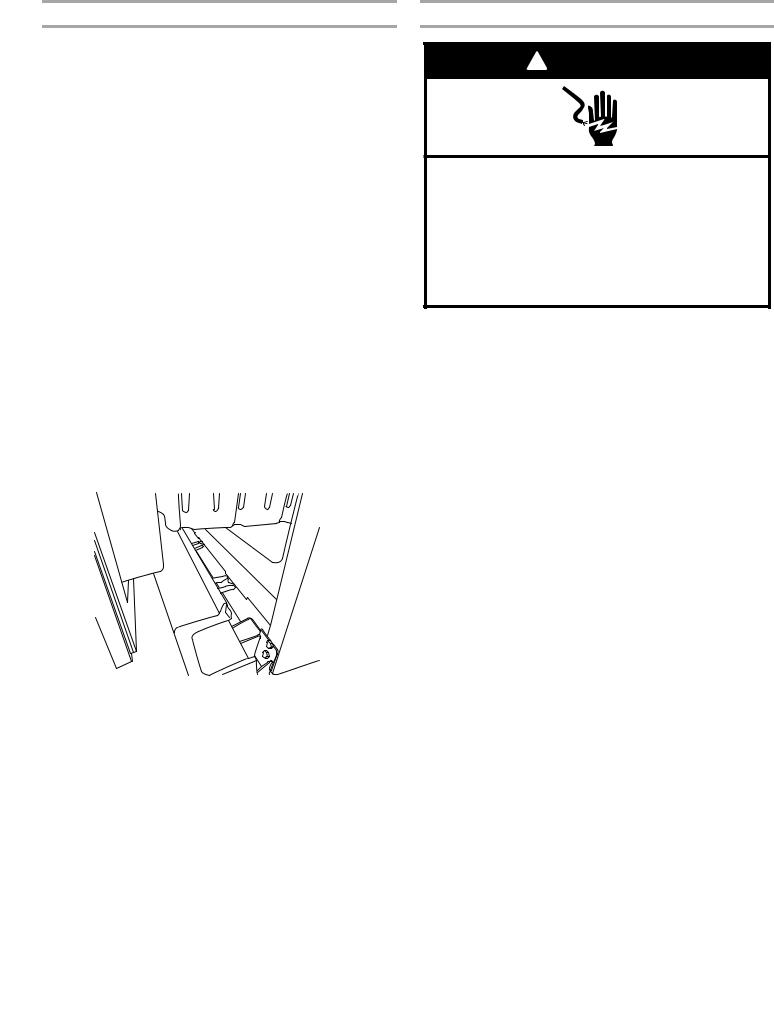
Remove and Replace Freezer Drawer Front
IMPORTANT: Two people may be required to remove and replace the freezer drawer. Graphics are included later in this section.
Remove Drawer Front
1.Open the freezer drawer to full extension.
2.Loosen the four screws attaching the drawer glides to the drawer front. See Drawer Front Removal graphic.
NOTE: Loosen screws three to four turns. Keep the screws in the drawer front.
3.Lift drawer front upward and off the screws. See Drawer Front Removal graphic.
4.The refrigerator leveling/roller assembly protrudes from each side of the cabinet base. Remove the three screws attaching each assembly, and remove the assemblies. See Refrigerator Leveling/Roller Assembly graphic.
Replace Drawer Front
1.Align the leveling/roller assembly with the holes on each side of the refrigerator cabinet. Using the screws removed, reinstall the assemblies to the cabinet base. Tighten the screws completely.
2.Slide the drawer glides out of the freezer compartment. Insert the screws in the top of the drawer front into the slots in the drawer brackets. See Drawer Front Replacement graphic.
3.Pull the drawer brackets toward you to position the two screws in the bottom of the drawer front into the brackets. Completely tighten the four screws. See Drawer Front Replacement graphic.
4.Replace the base grille.
■Pull open the freezer drawer.
■Align the three clips on the back of the base grille with the three tabs at the base of the refrigerator.
■Push the base grille in toward the refrigerator until it is firmly in place.
Final Steps
 WARNING
WARNING
Electrical Shock Hazard
Plug into a grounded 3 prong outlet.
Do not remove ground prong.
Do not use an adapter.
Do not use an extension cord.
Failure to follow these instructions can result in death, fire, or electrical shock.
1.Plug into a grounded 3 prong outlet.
2.Return all removable parts to doors and drawer and food to refrigerator and freezer.
 A
A
 B
B
A.Tab
B.Clip
5
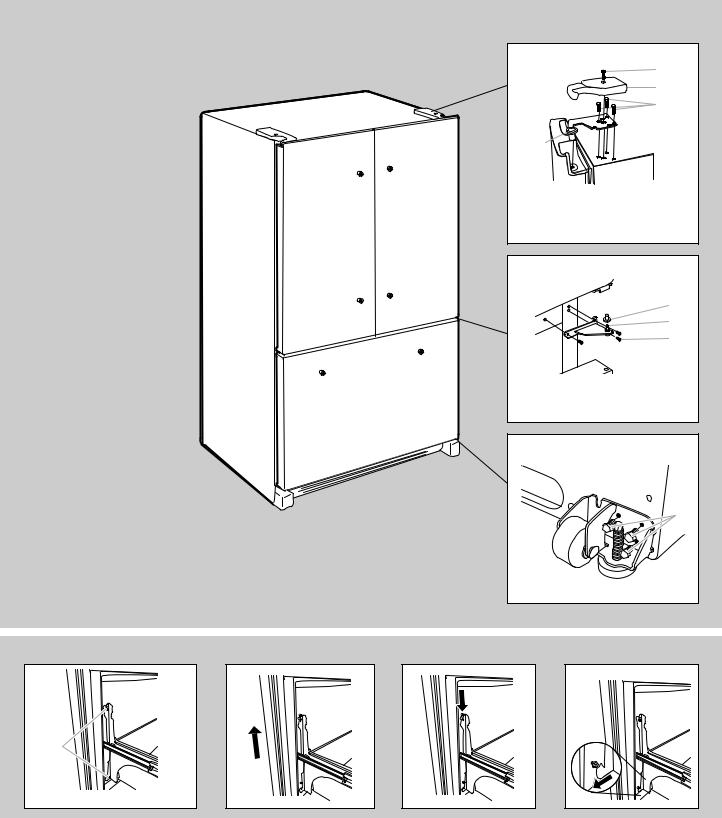
Style 1 - Non-Dispenser Models
Door Removal and Replacement
Top Hinges
A
B
C |
D 
A. Hinge Cover Screw
B. Top Hinge Cover
C. 5/16" Hex-Head Hinge Screws
D. Top Hinge
Bottom Hinges |
A |
B |
C |
A. Hinge Pin Cover |
B. Bottom Hinge |
C. Hinge Screws |
Leveling/Roller Assembly |
A |
A. Assembly Screws |
Drawer Front Removal |
Drawer Front Replacement |
A
A. Loosen 4 Door Bracket Screws
6

Style 2 - External Water Dispenser Models
Water Dispenser |
Tubing Connection |
A |
A. Blue Outer Ring |
Wiring Plug
Door Removal and Replacement
Top Hinges
A
B
C |
D 
A. Hinge Cover Screw
B. Top Hinge Cover
C. ⁄" Hex-Head Hinge Screws
D. Top Hinge
Bottom Hinges |
A |
B |
C |
A. Hinge Pin Cover |
B. Bottom Hinge |
C. Hinge Screws |
Leveling/Roller Assembly |
A |
A. Assembly Screws |
7
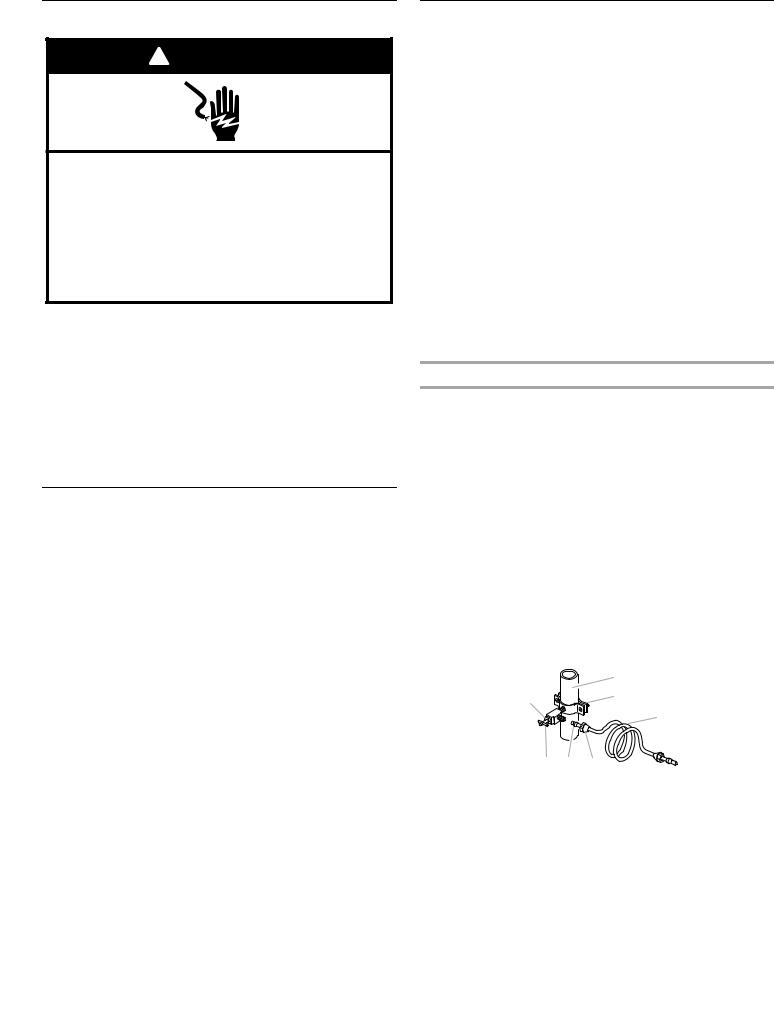
Electrical Requirements
 WARNING
WARNING
Electrical Shock Hazard
Plug into a grounded 3 prong outlet.
Do not remove ground prong.
Do not use an adapter.
Do not use an extension cord.
Failure to follow these instructions can result in death, fire, or electrical shock.
Before you move your refrigerator into its final location, it is important to make sure you have the proper electrical connection.
Recommended Grounding Method
A 115 volt, 60 Hz, AC only 15or 20-amp fused, grounded electrical supply is required. It is recommended that a separate circuit serving only your refrigerator and approved accessories be provided. Use an outlet that cannot be turned off by a switch. Do not use an extension cord.
NOTE: Before performing any type of installation, cleaning, or removing a light bulb, turn OFF Cooling, and then disconnect the refrigerator from the electrical source. When you have finished, reconnect the refrigerator to the electrical source and turn ON Cooling. See “Using the Control(s).”
Water Supply Requirements
A cold water supply with water pressure between 30 and 120 psi (207 and 827 kPa) is required to operate the water dispenser and ice maker. If you have questions about your water pressure, call a licensed, qualified plumber.
Reverse Osmosis Water Supply
IMPORTANT: The pressure of the water supply coming out of a reverse osmosis system going to the water inlet valve of the refrigerator needs to be between 30 and 120 psi (207 and 827 kPa).
If a reverse osmosis water filtration system is connected to your cold water supply, the water pressure to the reverse osmosis system needs to be a minimum of 40 to 60 psi (276 to 414 kPa).
If the water pressure to the reverse osmosis system is less than 40 to 60 psi (276 to 414 kPa):
■Check to see whether the sediment filter in the reverse osmosis system is blocked. Replace the filter if necessary.
■Allow the storage tank on the reverse osmosis system to refill after heavy usage. The tank capacity could be too low to keep up with the requirements of the refrigerator.
■If your refrigerator has a water filter, it may further reduce the water pressure when used in conjunction with a reverse osmosis system. Remove the water filter. See “Water Filtration System.”
Connect the Water Supply
Read all directions before you begin.
IMPORTANT:
■All installations must meet local plumbing code requirements.
■Use copper tubing or Whirlpool supply line, Part Number 8212547RP, and check for leaks.
■Install copper tubing only in areas where the temperatures will remain above freezing.
TOOLS NEEDED:
Gather the required tools and parts before starting installation. Read and follow the instructions provided with any tools listed here.
■ |
Flat-blade screwdriver |
■ |
¹⁄ " Nut driver |
■ |
⁄ " and ¹⁄ " Open-end or two |
■ |
¹⁄ " Drill bit |
|
adjustable wrenches |
■ |
Cordless drill |
|
|
NOTE: Your refrigerator dealer has a kit available with a ¹⁄ "
(6.35 mm) saddle-type shut-off valve, a union, and copper tubing. Before purchasing, make sure a saddle-type valve complies with your local plumbing codes. Do not use a piercing-type or ³⁄ "
(4.76 mm) saddle valve which reduces water flow and clogs more easily.
Connect to Water Line
Style 1
1.Unplug refrigerator or disconnect power.
2.Turn OFF main water supply. Turn ON nearest faucet long enough to clear line of water.
3.Locate a ½" to 1¹⁄ " (1.25 cm to 3.18 cm) vertical cold water pipe near the refrigerator.
IMPORTANT:
■Make sure it is a cold water pipe.
■Horizontal pipe will work, but drill on the top side of the pipe, not the bottom. This will help keep water away from the drill and normal sediment from collecting in the valve.
4.Determine the length of copper tubing you need. Measure from the connection on the lower left rear of refrigerator to the water pipe. Add 7 ft (2.1 m) to allow for cleaning. Use ¹⁄ " (6.35 mm)
O.D. (outside diameter) copper tubing. Be sure both ends of copper tubing are cut square.
5.Using a cordless drill, drill a ¹⁄ " hole in the cold water pipe you have selected.
|
A |
G |
B |
|
|
|
C |
F E |
D |
A. Cold water pipe |
E. Compression sleeve |
B. Pipe clamp |
F. Shut-off valve |
C. Copper tubing |
G. Packing nut |
D.Compression nut
6.Fasten the shut-off valve to the cold water pipe with the pipe clamp. Be sure the outlet end is solidly in the ¹⁄ " (6.35 mm) drilled hole in the water pipe and that the washer is under the pipe clamp. Tighten the packing nut. Tighten the pipe clamp screws slowly and evenly so washer makes a watertight seal. Do not overtighten or you may crush the copper tubing.
8
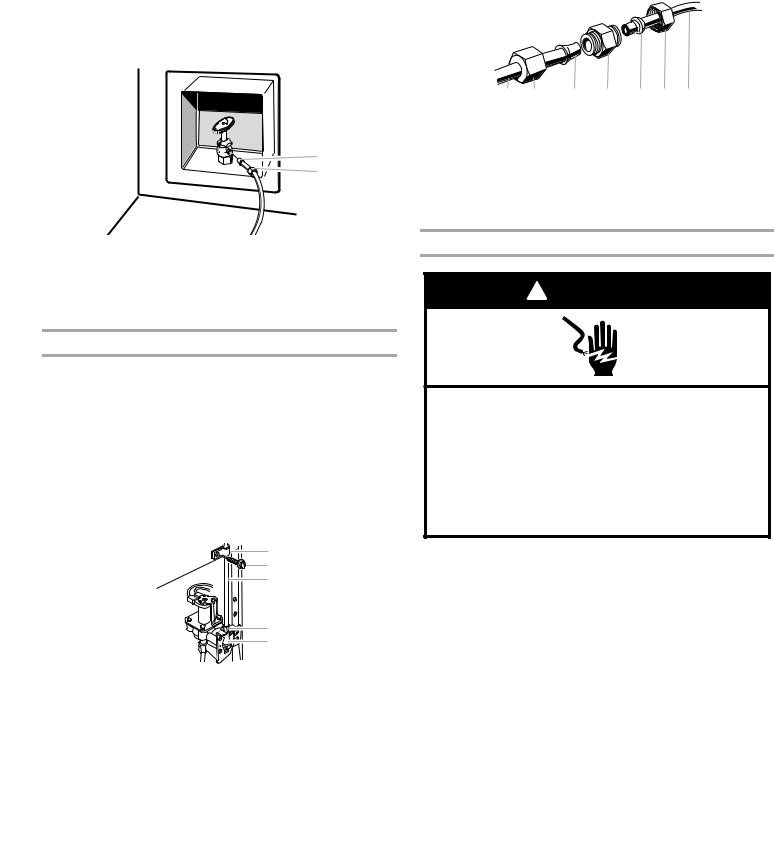
7.Slip the compression sleeve and compression nut onto the copper tubing as shown. Insert the end of the tubing into the outlet end squarely as far as it will go. Screw compression nut onto outlet end with adjustable wrench. Do not overtighten.
8.Place the free end of the tubing in a container or sink, and turn ON the main water supply. Flush the tubing until water is clear. Turn OFF the shut-off valve on the water pipe. Coil the copper tubing.
Style 2
1.Unplug refrigerator or disconnect power.
2.Remove and discard the black nylon plug from the gray water tube on the rear of the refrigerator.
3.Thread the provided nut onto the water valve as shown.
NOTE: Tighten the nut by hand. Then tighten it with a wrench two more turns. Do not overtighten.
A |
B |
A.Bulb
B.Nut (provided)
4.Turn shut-off valve ON.
5.Check for leaks. Tighten any nuts or connections (including connections at the valve) that leak.
Connect to Refrigerator
Style 1
1.Unplug refrigerator or disconnect power.
2.Attach the copper tube to the valve inlet using a compression nut and sleeve as shown. Tighten the compression nut. Do not overtighten.
3.Use the tube clamp on the back of the refrigerator to secure the tubing to the refrigerator as shown. This will help avoid damage to the tubing when the refrigerator is pushed back against the wall.
4.Turn shut-off valve ON.
5.Check for leaks. Tighten any connections (including connections at the valve) or nuts that leak.
A
B
C
D
E
A. Tube clamp |
D. Compression nut |
B. Tube clamp screw |
E. Valve inlet |
C.Copper tubing
6.On models with ice makers, the ice maker is equipped with a built-in water strainer. If your water conditions require a second water strainer, install it in the ¹⁄ " (6.35 mm) water line at either tube connection. Obtain a water strainer from your nearest appliance dealer.
Style 2
1.Unplug refrigerator or disconnect power.
2.Remove and discard the black nylon plug from the gray water tube on the rear of the refrigerator.
3.If the gray water tube supplied with the refrigerator is not long enough, a ¹⁄ " x ¹⁄ " (6.35 mm x 6.35 mm) coupling is needed in order to connect the water tubing to an existing household water line. Thread the provided nut onto the coupling on the end of the copper tubing.
NOTE: Tighten the nut by hand. Then tighten it with a wrench two more turns. Do not overtighten.
A |
B |
C |
D |
E F G |
A. Refrigerator water tubing |
|
E. Ferrule (purchased) |
||
B. Nut (provided) |
|
|
F. Nut (purchased) |
|
C. Bulb |
|
|
|
G.Household water line |
D.Coupling (provided)
4.Turn shut-off valve ON.
5.Check for leaks. Tighten any nuts or connections (including connections at the valve) that leak.
Complete the Installation
 WARNING
WARNING
Electrical Shock Hazard
Plug into a grounded 3 prong outlet.
Do not remove ground prong.
Do not use an adapter.
Do not use an extension cord.
Failure to follow these instructions can result in death, fire, or electrical shock.
1. Plug into a grounded 3 prong outlet.
NOTES:
■Allow 24 hours to produce the first batch of ice. Discard the first three batches of ice produced. Allow 3 days to completely fill ice container.
■For models with a water dispenser, flush the water system. See “Water Dispenser.”
9
